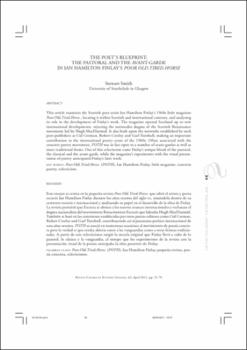The Poet's Blueprint: The Pastoral and the Avant-Garde in Ian Hamilton Finlay's Poor.Old.Tired.Horse
Autor
Smith, StewartFecha
2011Resumen
This article examines the Scottish poet-artist Ian Hamilton Finlay’s 1960s little magazine Poor.Old.Tired.Horse., locating it within Scottish and international contexts, and analysing its role in the development of Finlay’s work. The magazine opened Scotland up to new international developments, rejecting the nationalist dogma of the Scottish Renaissance movement led by Hugh MacDiarmid. It also built upon the networks established by such poet-publishers as Cid Corman, Robert Creeley and Gael Turnbull, making an important contribution to the international poetry scene of the 1960s. Often associated with the concrete poetry movement, POTH was in fact open to a number of avant-gardes as well as
more traditional forms. Out of this eclecticism came Finlay’s unique blend of the pastoral, the classical and the avant-garde, while the magazine’s experiments with the visual presentation of poetry anticipated Finlay’s later work Este ensayo se centra en la pequeña revista Poor.Old.Tired.Horse. que editó el artista y poeta
escocés Ian Hamilton Finlay durante los años sesenta del siglo XX, situándola dentro de su
contexto escocés e internacional y analizando su papel en el desarrollo de la obra de Finlay.
La revista permitió que Escocia se abriese a los nuevos avances internacionales y rechazase el
dogma nacionalista del movimiento Renacimiento Escocés que lideraba Hugh MacDiarmid.
También se basó en las conexiones establecidas por otros poetas-editores como Cid Corman,
Robert Creeley and Gael Turnbull, contribuyendo así al panorama poético internacional de
esos años sesenta. POTH se asoció en numerosas ocasiones al movimiento de poesía concreta pero la verdad es que estaba abierta tanto a las vanguardias como a otras formas tradicionales. A partir de este eclecticismo surgió la mezcla original que Finlay llevó a cabo de lo
pastoril, lo clásico y la vanguardia, al tiempo que los experimentos de la revista con la
presentación visual de la poesía anticipaba la obra posterior de Finlay.





